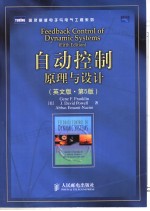

FEEDBACK CONTROL OF DYNAMIC SYSTEMS (FIFTH EDITION)PDF电子书下载
- 电子书积分:18 积分如何计算积分?
- 作 者:[美]GENE F.FRANKLIN J.DAVID POWELL ABBAS EMAMI-NAEINI著
- 出 版 社:人民邮电出版社
- 出版年份:2007
- ISBN:9787115158536
- 页数:609 页
1 An Overview and Brief History of Feedback Control 1
A Perspective on Feedback Control 1
Chapter Overview 1
1.1 A Simple Feedback System 2
1.2 A First Analysis of Feedback 5
1.3 A Brief History 7
1.4 An Overview of the Book 12
Summary 13
End-of-Chapter Questions 14
Problems 14
2 Dynamic Models 17
A Perspective on Dynamic Models 17
Chapter Overview 17
2.1 Dynamics of Mechanical Systems 18
2.2 Models of Electric Circuits 28
2.3 Models of Electromechanical Systems 31
2.4 Heat and Fluid-Flow Models 36
2.5 Complex Mechanical Systems 45
Summary 49
End-of-Chapter Questions 49
Problems 50
3 Dynamic Response 58
A Perspective on System Response 58
Chapter Overview 58
3.1 Review of Laplace Transforms 58
3.2 System Modeling Diagrams 80
3.3 Effect of Pole Locations 84
3.4 Time-Domain Specifications 90
3.5 Effects of Zeros and Additional Poles 94
3.6 Amplitude and Time Scaling 98
3.7 Stability 100
3.8 Obtaining Models from Experimental Data 108
3.9 Mason’s Rule and the Signal-Flow Graph 109
Summary 112
End-of-Chapter Questions 113
Problems 114
4 Basic Properties of Feedback 127
A Perspective on the Properties of Feedback 127
Chapter Overview 127
4.1 The Basic Equations of Control 128
4.2 Control of Steady-State Error: System Type 134
4.3 Control of Dynamic Error: PID Control 142
4.4 Extensions to the Basic Feedback Concepts 146
Summary 160
End-of-Chapter Questions 161
Problems 161
5 The Root-Locus Design Method 177
A Perspective on the Root-Locus Design Method 177
Chapter Overview 177
5.1 Root Locus of a Basic Feedback System 178
5.2 Guidelines for Sketching a Root Locus 182
5.3 Selected Illustrative Root Loci 191
5.4 Selecting the Parameter Value 201
5.5 Design Using Dynamic Compensation 203
5.6 A Design Example Using the Root Locus 210
5.7 Extensions of the Root-Locus Method 215
Summary 222
End-of-Chapter Questions 223
Problems 224
6 The Frequency-Response Design Method 239
A Perspective on the Frequency-Response Design Method 239
Chapter Overview 239
6.1 Frequency Response 240
6.2 Neutral Stability 256
6.3 The Nyquist Stability Criterion 258
6.4 Stability Margins 267
6.5 Bode’s Gain-Phase Relationship 272
6.6 Closed-Loop Frequency Response 275
6.7 Compensation 276
6.8 Alternative Presentations of Data 295
6.9 Specifications in Terms of the Sensitivity Function 299
6.10 Time Delay 305
Summary 307
End-of-Chapter Questions 309
Problems 310
7 State-Space Design 329
A Perspective on State-Space Design 329
Chapter Overview 329
7.1 Advantages of State Space 330
7.2 System Description in State Space 331
7.3 Block Diagrams and State Space 336
7.4 Analysis of the State Equations 339
7.5 Control-Law Design for Full-State Feedback 355
7.6 Selection of Pole Locations for Good Design 366
7.7 Estimator Design 374
7.8 Compensator Design: Combined Control Law and Estimator 385
7.9 Introduction of the Reference Input with the Estimator 396
7.10 Integral Control and Robust Tracking 406
7.11 Loop Transfer Recovery (LTR) 420
7.12 Direct Design with Rational Transfer Functions 424
7.13 Design for Systems with Pure Time Delay 427
Summary 431
End-of-Chapter Questions 432
Problems 434
8 Digital Control 452
A Perspective on Digital Control 452
Chapter Overview 452
8.1 Digitization 452
8.2 Dynamic Analysis of Discrete System 454
8.3 Design Using Discrete Equivalents 460
8.4 Hardware Characteristics 468
8.5 Sample-Rate Selection 471
8.6 Discrete Design 473
8.7 State-Space Design Methods 479
Summary 485
End-of-Chapter Questions 486
Problems 487
9 Nonlinear Systems 497
Perspective on Nonlinear Systems 497
Chapter Overview 497
9.1 Introduction and Motivation: Why Study Nonlinear Systems? 498
9.2 Analysis by Linearization 499
9.3 Equivalent Gain Analysis Using the Root Locus 505
9.4 Equivalent Gain Analysis Using Frequency Response: Describing Functions 513
9.5 Analysis and Design Based on Stability 522
Summary 537
End-of-Chapter Questions 537
Problems 538
10 Control System Design: Principles and Case Studies 545
A Perspective on Design Principles 545
Chapter Overview 545
10.1 An Outline of Control Systems Design 545
10.2 Design of a Satel lite’s Attitude Control 550
10.3 Lateral and Longitudinal Control of a Boeing 747 561
10.4 Control of the Fuel-Air Ratio in an Automotive Engine 574
10.5 Control of the Read/Write Head Assembly of a Hard Disk 580
10.6 Control of Rapid Thermal Processing (RTP) Systems in Semiconductor Wafer Manufacturing 586
Summary 597
End-of-Chapter Questions 599
Problems 599
- 《SQL与关系数据库理论》(美)戴特(C.J.Date) 2019
- 《魔法销售台词》(美)埃尔默·惠勒著 2019
- 《看漫画学钢琴 技巧 3》高宁译;(日)川崎美雪 2019
- 《优势谈判 15周年经典版》(美)罗杰·道森 2018
- 《社会学与人类生活 社会问题解析 第11版》(美)James M. Henslin(詹姆斯·M. 汉斯林) 2019
- 《海明威书信集:1917-1961 下》(美)海明威(Ernest Hemingway)著;潘小松译 2019
- 《迁徙 默温自选诗集 上》(美)W.S.默温著;伽禾译 2020
- 《上帝的孤独者 下 托马斯·沃尔夫短篇小说集》(美)托马斯·沃尔夫著;刘积源译 2017
- 《巴黎永远没个完》(美)海明威著 2017
- 《剑桥国际英语写作教程 段落写作》(美)吉尔·辛格尔顿(Jill Shingleton)编著 2019
- 《办好人民满意的教育 全国教育满意度调查报告》(中国)中国教育科学研究院 2019
- 《人民院士》吴娜著 2019
- 《中国人民的心》杨朔著;夕琳编 2019
- 《中华人民共和国成立70周年优秀文学作品精选 短篇小说卷 上 全2册》贺邵俊主编 2019
- 《中华人民共和国成立70周年优秀文学作品精选 中篇小说卷 下 全3册》洪治纲主编 2019
- 《中华人民共和国药典中成药薄层色谱彩色图集》(中国)国家药典委员会 2019
- 《北京人民艺术剧院剧本系列 白露》刘国华,马鹏程 2019
- 《中华人民共和国成立70周年优秀文学作品精选 中篇小说卷 上 全3册》洪治纲主编 2019
- 《中华人民共和国国歌 钢琴谱》聂耳编 2019
- 《中国人民大学研究报告系列 中国水处理行业可持续发展战略研究报告 膜工业卷 3》(中国)郑祥,魏源送,王志伟 2019
